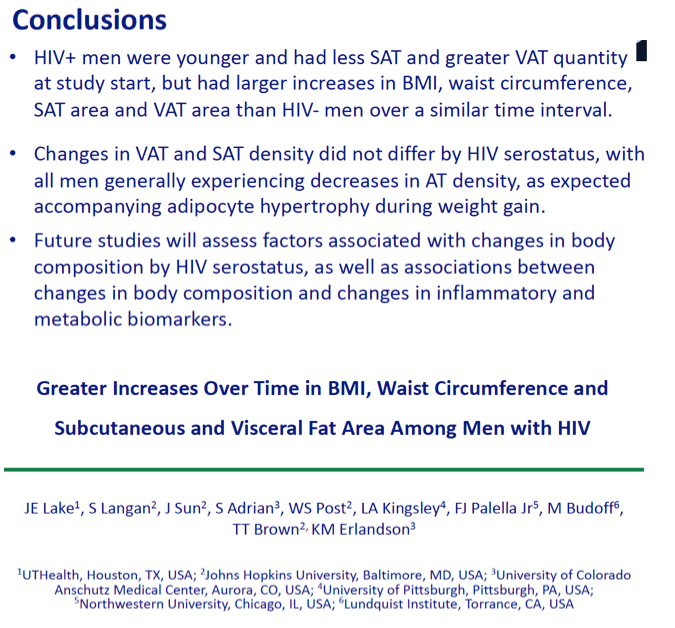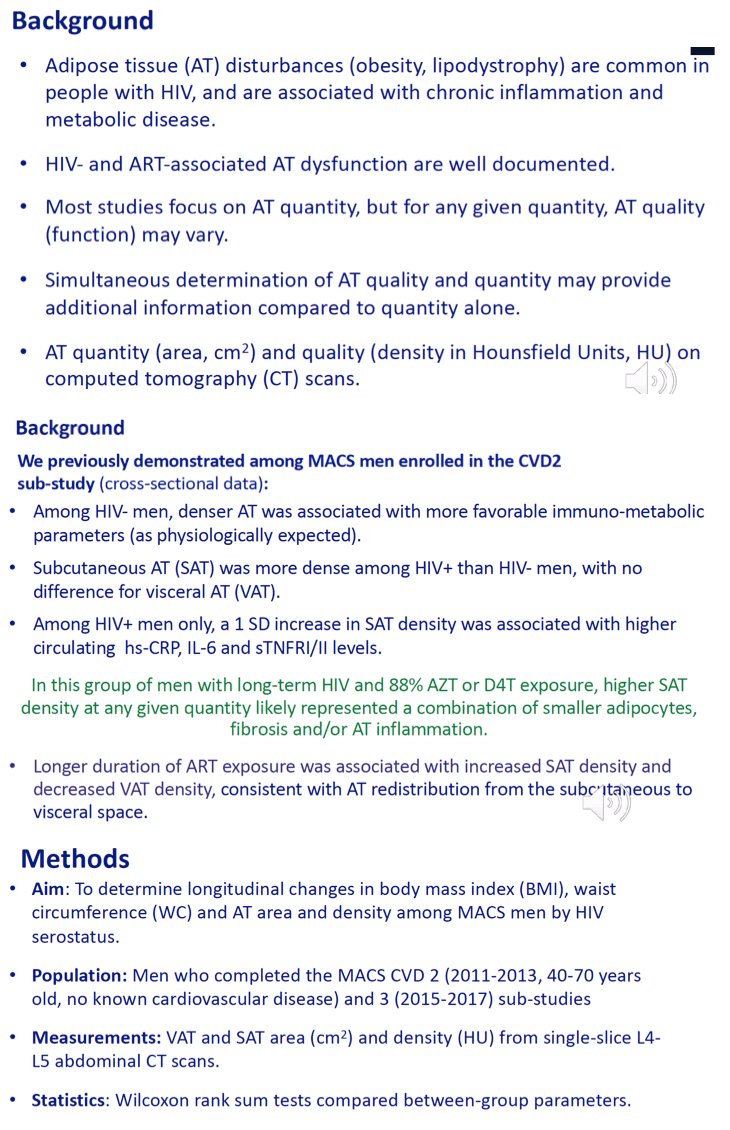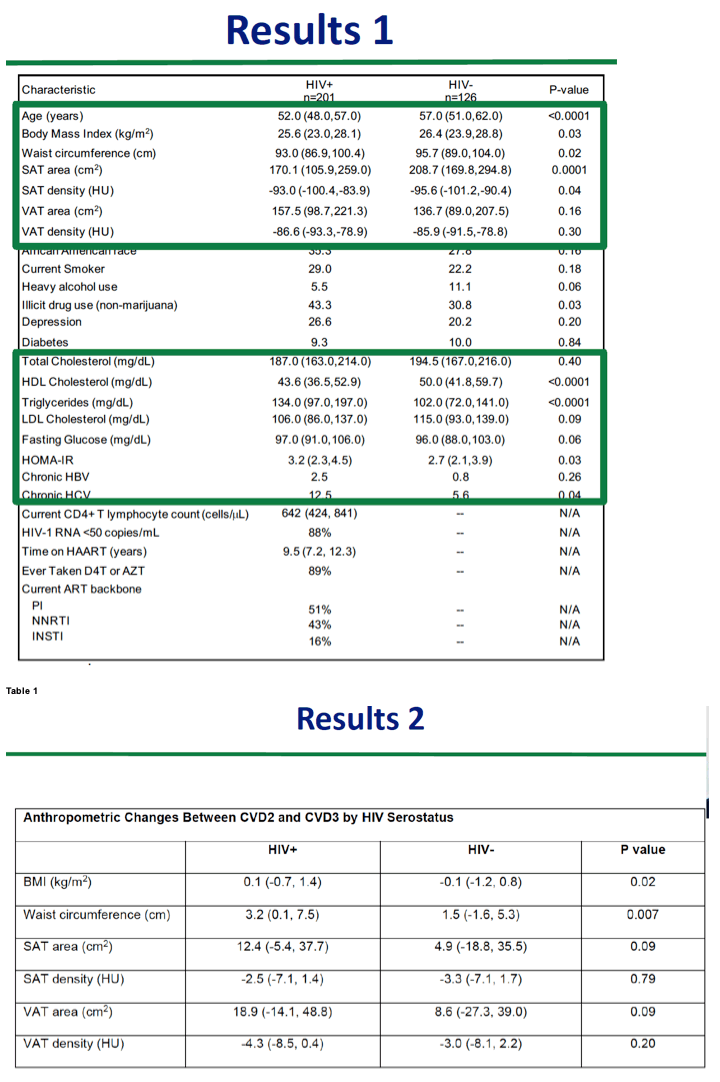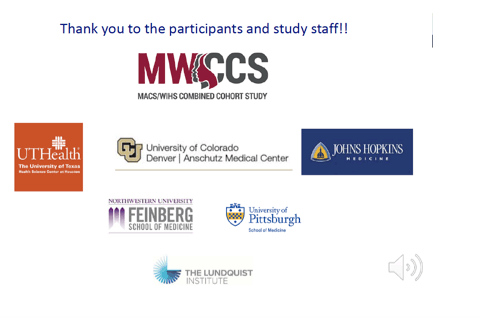 |
 |
 |
| |
Greater Increases Over Time in BMI, Waist Circumference and
Subcutaneous and Visceral Fat Area Among Men with HIV
|
| |
| |
Conclusions: Although HIV+ men were younger and had less SAT at study start, HIV+ men had larger increases in BMI, waist circumference, SAT area and VAT area than HIV- men over a similar time interval. Changes in VAT and SAT density did not differ by HIV serostatus, with all men generally experiencing decreases in AT density, as expected accompanying adipocyte hypertrophy during weight gain.
Virtual 2020 International Workshop on Comorbidities & Adverse Drug Reactions in HIV
Reported by Jules Levin
JE Lake1, S Langan2, J Sun2, S Adrian3, WS Post2, LA Kingsley4, FJ Palella Jr5, M Budoff6, TT Brown2, KM Erlandson3
1UTHealth, Houston, TX, USA; 2Johns Hopkins University, Baltimore, MD, USA; 3University of Colorado Anschutz Medical Center, Aurora, CO, USA; 4University of Pittsburgh, Pittsburgh, PA, USA; 5Northwestern University, Chicago, IL, USA; 6Lundquist Institute, Torrance, CA, USA

Abstract
Greater increases over time in BMI, waist circumference and subcutaneous and visceral fat area among men with HIV
JE Lake1, S Langan2, J Sun2, S Adrian3, WS Post2, LA Kingsley4, FJ Palella Jr5, M Budoff6, TT Brown2, KM Erlandson3
1UTHealth, Houston, TX, USA; 2Johns Hopkins University, Baltimore, MD, USA; 3University of Colorado Anschutz Medical Center, Aurora, CO, USA; 4University of Pittsburgh, Pittsburgh, PA, USA; 5Northwestern University, Chicago, IL, USA; 6Harbor-UCLA Medical Center, Torrance, CA, USA
Objectives: Adipose tissue (AT) abnormalities are common in people with HIV (HIV+) and are associated with metabolic disease. AT area and density may provide complimentary information. In the traditional obesity paradigm, increases in AT area are associated with decreases in density due to lipid engorgement of adipocytes. We assessed longitudinal changes in AT area and density by HIV serostatus among men in the Multicenter AIDS Cohort Study (MACS).
Methods: Men who completed MACS sub-studies CVD2 (2011–2013, 40–70 years old, no known cardio- vascular disease) and CVD3 (2015–2017) underwent measurement of visceral (VAT) and subcutaneous (SAT) AT area (cm2) and density (Hounsfield Units [HU]) from single-slice L4-L5 abdominal CT scans. Wilcoxon rank sum tests compared between-group parameters.
Results: At CVD2, HIV+ (n=201) and HIV-negative (HIV-, n=126) men had median age 52 and 57 years,
See Table 1. below
BMI 26 kg/m2 (both groups), 35% and 28% were Black, and 12% and 7% were Hispanic, respectively. HIV+ men had current median CD4+ T-lymphocyte count 642 cells/ml, 88% HIV-1 RNA <50 copies/ml, 10 years on highly active antiretroviral therapy (HAART, 89% with historical thymidine analogue NRTI exposure). Current ART use was 51% PI-, 43% NNRTI- and 16% INSTI-based. VAT area (HIV- 137 cm2, HIV+ 158 cm2; P=0.16) and density (HIV- -86 HU, HIV+ -87 HU; P=0.30) were similar by HIV serostatus, but HIV- men had greater SAT area (209 versus 170 cm2; P=0.0001) and less dense SAT (-96 versus -93 HU; P=0.04).
Over a median of 4.8 years, HIV+ men experienced small but significant increases in BMI and waist circumference, with a trend towards greater SAT and VAT area gain than HIV- men. However, changes in VAT and SAT density were similar for HIV+ and HIV- men (Table 1). Concordance in directionality of changes in SAT and VAT area (HIV+ 71%, HIV- 77%) and density (92% for both) changes were high, suggesting frequency of redistribution from subcutaneous to visceral depots was low and not significantly more common among HIV+ men.
Conclusions: Although HIV+ men were younger and had less SAT at study start, HIV+ men had larger increases in BMI, waist circumference, SAT area and VAT area than HIV- men over a similar time interval. Changes in VAT and SAT density did not differ by HIV serostatus, with all men generally experiencing decreases in AT density, as expected accompanying adipocyte hypertrophy during weight gain.



|
| |
|
 |
 |
|
|